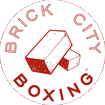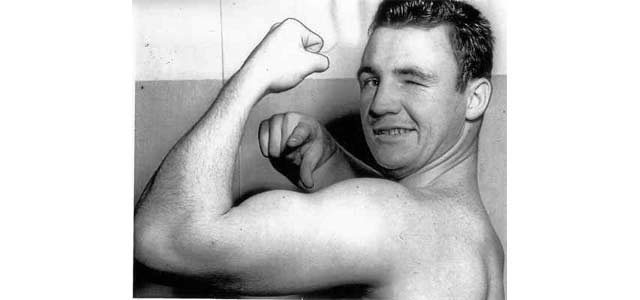From the small town of Phoenixville, PA, (west of Philadelphia) came “Irish” Joe Rowan a good looking kid who was 26-0 in the amateurs and was in the National Golden Gloves finals against another kid named Floyd Patterson. Patterson won the fight and went onto the Olympics and won a Gold Medal in the Middleweight division and would become the heavyweight champion of the world.
The point of this article is what happens when a local boxer from a small town has worlds of potential but has co-managers who rush him too fast hoping to get more money in return. Rowan was a perfect example from 1952 to 1959 lost six of his last nine fights mostly on cuts. Even back then a good looking Irish heavyweight was an attraction especially when he could punch like Rowan could.
Rowan would turn professional a month past his eighteenth birthday in June of 1952 at Philadelphia’s Toppi Stadium scoring a stoppage in the second round over Philly’s Charlie Coles. Rowan weighed in at 163. He would have nine fights in the six months in 1952. He won three fights in June.
Rowan won his first seven fights, five by stoppage. He fought his next fights three times in Chester which is just outside of Philly and two in upstate PA in Wilkes-Barre. His seventh fight was in Brooklyn, NY. In October and December he lost back to back decisions first to Don Alva at the Cambria A.C. in Philly whom he would defeat in their next two fights. Then he lost to Peter Nelson as Madison Square Garden when he twisted his knee and went down in the first round.
In February of 1953 Rowan would start a five-fight win streak defeating Andre Tessier. In May he would score a first round knockout just three days later over Billy Robinson at the Atlantic City Convention Center. In March in a return match with Alva at the Cambria A.C. in Philly in his first eight rounder Rowan stopped Alva who was now 6-4 in the fifth round.
Less than a month later Rowan stopped Ernie Sanders, 2-5-1, in the first round at the Philadelphia Arena. Just eleven days later he stopped Rudy Franklin, 11-7-3, in the fourth of an eight rounder at the Cambria A.C. In May he lost a decision to New Jersey’s Harold Carter a future contender who was making his debut in Newark, NJ, and would win his first eleven fights.
Four weeks later Rowan would be back in Madison Square Garden defeating Philly’s Bobby “Red” Brandt, 11-2, over six rounds. Just six weeks later in August of 1953 in a rematch Rowan got cut in the first round over his left eye from an accidental head butt. The ring doctor wouldn’t allow Rowan out for the second round in a scheduled eight.
The following month Rowan would have his third fight with Alva which would be the “rubber match”. It was held at the Philadelphia Arena and Rowan won over six rounds. In February of 1954 Rowan would meet Ted Calaman, 30-3-1, at the Cambria A.C. and stop Calaman in the eighth and final round.
Just three weeks later Rowan would return to Madison Square Garden and defeat Tommy “Eldridge” Thompson, 16-3, of D.C. over eight rounds. At Yankee Stadium he would drop back to back decisions to Joe Gannon, 30-3, both over six rounds.
Just four weeks later Rowan with be back in the ring starting a seven fight winning streak. He defeated Paul Wright, 13-2, in December of 1954. On January 11th in 1955 he would score wins over Carlton Moore in Trenton, NJ, and just two days later Zack Hobbs at the Plaza in Philadelphia both over eight rounds. It would be the first of three matches with Hobbs. Moore and Hobbs were both main events.
It was time to step up the competition when Rowan fought Bert Whitehurst, 20-6-2, from Baltimore, held in Trenton. He had defeated Tommy “Hurricane” Jackson, 10-0-1, and Al Schlimm, 21-0, in back to back fights. It would be the first time Whitehurst was knocked out and it only took Rowan 1:02 of the first round.
Just twenty days later Rowan would take on another tough guy in Wayne Bethea, 6-1-1, in his first ten rounder. Rowan took a split decision win but broke his hand. Bethea had stopped Harold Carter, 11-0, in his previous fight. It was held in the Eastern Parkway Arena, in Brooklyn. Rowan would be off close to four months to heal the hand.
In July of 1955 Rowan would travel to Miami Beach and take on Bob Satterfield, 38-19-2. A year before this match Satterfield had knocked out Cleveland “Big Cat” Williams, 33-1, in Miami Beach. The battle would end in a draw over ten rounds. In Satterfield’s next fight he defeated the Cuban Nino Valdez, 32-9-3, though giving away thirty-two pounds.
Two months later Rowan would defeat Detroit’s Ken “Mike” Hammer, by split decision over ten rounds in Miami Beach. In November Rowan would take on future world light heavyweight champion Willie Pastrano, 32-4-4, at Madison Square Garden and lost a decision over ten rounds. “Speed beat Rowan, but I was lucky,” said Pastrano.
Al Weill the manager of Rocky Marciano tried to buy Rowan’s contract but was unsuccessful. Rowan’s co-managers were Carmen Graziano and Tony Ferrante. Both would have legal problems. Some of the comments written about Rowan were: “Rowan’s right rarely travels more than six inches. It is swift, powerful and almost impossible to stop.” Another was He has the true form of a power hitter. His right hand when he throws it is reminiscent of the short powerful blows that carried Joe Louis to the heavyweight championship.”
Rowan had such trainers as Adolph Ritacci, Mickey Diamond and Quenzel McCall. The bottom line is Rowan like Floyd Patterson fought in the National Golden Gloves final as a middleweight. As a professional his lowest was 158 and his highest weight was 193.
Rowan trained professionals “Wicket” Joe Pickett, Greg Haley, Jack Caroselli and Chris Organtini at the Valley Forge Boxing Club in Phoenixville which was in the then Valley Forge Christian College.


